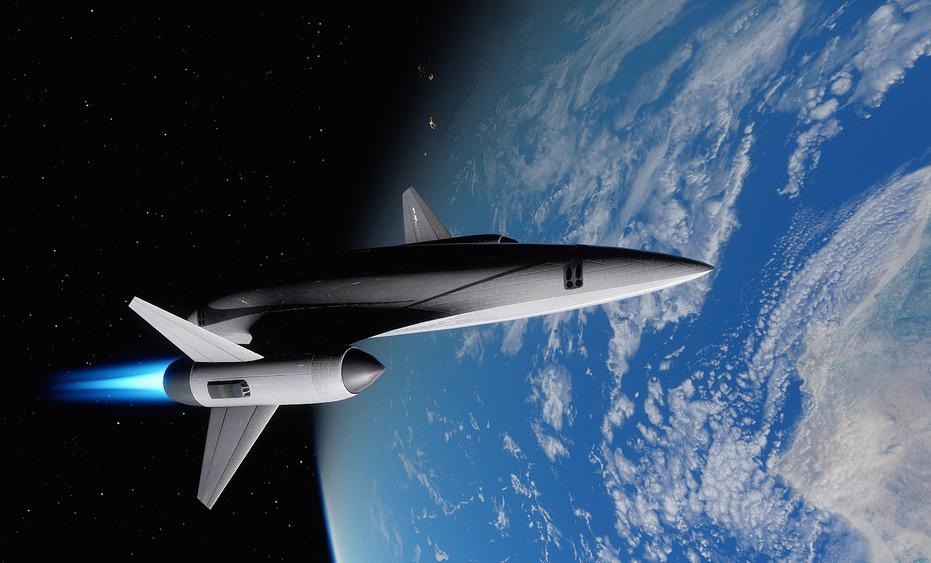Research into hypersonic flight began back in the 1960s with experiments involving the X-15 rocket-plane. To date, only a few experimental piloted hypersonic planes have successfully reached speeds above Mach 5, which is equivalent to more than 6,100km an hour. Only when this speed is reached are they considered hypersonic.

Image Credit: AleksandrMorrisovich/Shutterstock.com
Scientists are interested in developing hypersonic because it would allow long-haul flights to be completed in just a few hours. Flights from London to Sydney, for example, would take just four hours. However, advancements have faced challenges such as the extreme heat that aircraft experience when moving at hypersonic speeds. Now, new research published August 25th, 2021, in the journal Chemical Communications, demonstrates how this limitation may be tackled using 3D printed catalysts.
What are 3D Printed Catalysts?
Additive manufacturing, or 3D printing, is the process of creating objects by layering materials upon one another in a precise manner. The method, which is the opposite of conventional subtractive construction techniques, has been around since the 1980s. It has recently grown in popularity as scientific advancements have expanded the number of practical applications of the technique.
One such application is that of printing catalysts, as 3D printing allows them to be created with specific properties. Chemical and industrial processes that rely on such materials can be enhanced with 3D printing, allowing them to obtain catalysts tailored to fit their purpose.
3D printing has been used to support the production of catalysts for the past two decades. In 2003, for instance, it was utilized to build ceramic support structures of aluminum oxide, which were used as monolithic catalysts. Additionally, as part of the same research project, catalysts made entirely of hexaaluminate were built by 3D printing.
In a new research project, scientists have 3D printed metal alloys into tiny heat exchangers and coated them with zeolites to create catalysts. The hope is that these materials will help advance the development of hypersonic flight.
Pushing Hypersonic Flight Forward with the Help of 3D Printed Catalysts
The ultra-efficient 3D printed catalysts created by the team at the Royal Melbourne Institute of Technology (RMIT) could be fundamental in overcoming the challenge of overheating in hypersonic aircraft. The study shows that these catalysts may provide cutting-edge thermal management that could be implemented across a range of industries.
Researchers report these new materials to be cost-effective with a scalable production, a feature that would benefit the aviation industry in the development of commercial hypersonic flights.
Overcoming the Issue of Overheating
Hypersonic flight vehicles are at risk of overheating due to the extreme temperatures generated from moving at incredibly fast speeds. The 3D printed catalysts developed by the team at RMIT could overcome this challenge by making fuel coolants more efficient and effective.
Scientists have identified that fuels with the capability to absorb heat while powering the aircraft could answer the overheating problem. However, to allow fuels to have sufficient cooling power, heat-consuming chemical reactions are required; highly efficient catalysts are needed to power these reactions.
3D printed catalysts have been proven to be highly efficient and could, theoretically, provide sufficient cooling power while simultaneously powering hypersonic aircraft.
A Revolutionary Solution to Thermal Management Across Industries
The new 3D printed catalysts act like chemical reactors as the structures heat up and the metals move into the zeolite framework, which is the key to the incredibly high effectiveness of the catalysts.
Next, scientists will need to uncover more about the nature of the catalysts that they have created. The team plans to study them with an X-ray synchrotron to understand the best combination of metal alloys for the highest efficiency. Once optimized, the 3D catalysts will not only be useful to advancing the field of hypersonic flight, but all industries that rely on efficient chemical reactions may also benefit.
This revolutionary approach to thermal management could be leveraged into a range of potential applications, including those that manage air pollution to improve indoor air quality. This area has become intensely focused on since the start of the pandemic.
The Future for 3D Printed Catalysts and Hypersonic Flight
Currently, there is minimal research into 3D printed catalysts and hypersonic flight. Before these new catalysts can be used in hypersonic aircraft fuel, further studies are required to understand its properties, how it can be optimized, its safety, and the applicability of 3D catalysts in other applications. In the coming years, we will likely see more studies in this field.
References and Further Reading
Hubesch, R., Mazur, M., Föger, K., Selvakannan, P. and Bhargava, S., (2021) Zeolites on 3D-printed open metal framework structure: metal migration into zeolite promoted catalytic cracking of endothermic fuels for flight vehicles. Chemical Communications. Available at: https://doi.org/10.1039/D1CC04246G
Dempsey, M., (2020) Rival powers jockey for the lead in hypersonic aircraft. [online] BBC News. Available at: https://www.bbc.co.uk/news/business-53598874
RMIT University. (2021) Next-gen 3D printed catalysts to propel hypersonic flight. [online] Phys.org. Available at: https://phys.org/news/2021-09-next-gen-3d-catalysts-propel-hypersonic.html
Disclaimer: The views expressed here are those of the author expressed in their private capacity and do not necessarily represent the views of AZoM.com Limited T/A AZoNetwork the owner and operator of this website. This disclaimer forms part of the Terms and conditions of use of this website.